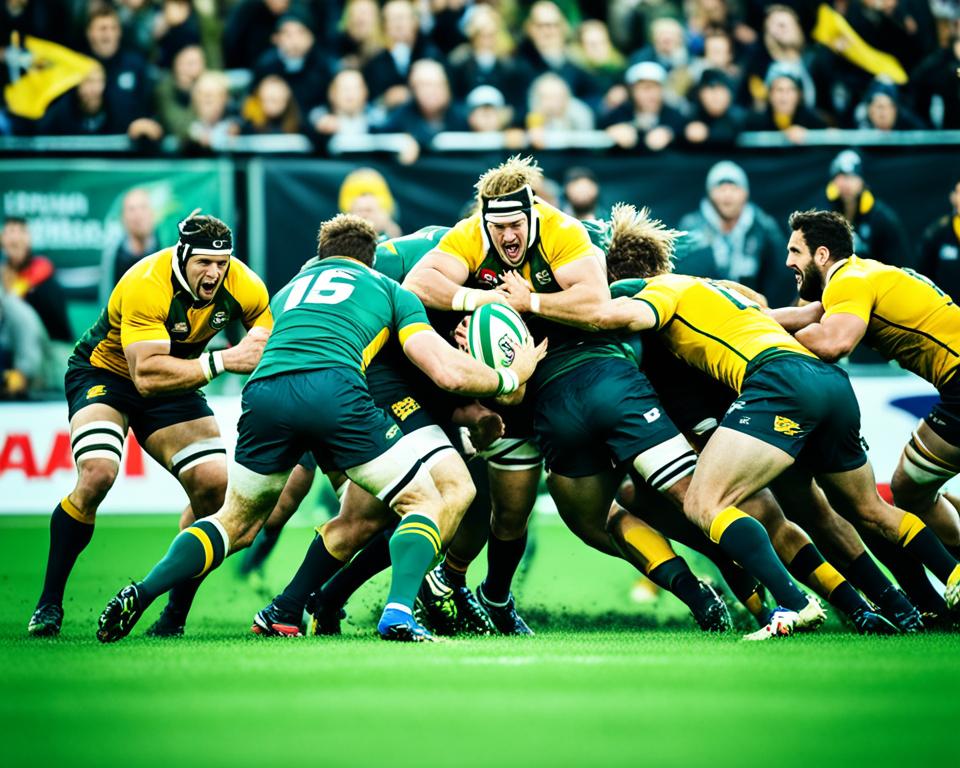The rugby world in Australia is experiencing a dynamic transformation, with several key developments shaping the future of the sport. Six prominent member unions, including Queensland, ACT, and Western Australia, have expressed concerns about the centralisation proposals put forth by Rugby Australia, leading to calls for the resignation of the organisation’s chairman, Hamish McLennan. This request, however, is not about opposition to the centralisation plans, but rather a desire for a more substantive strategy and a clear outline of how the proposed changes would work.
The article will delve into the benefits of a centralised model, drawing comparisons to the success of the All Blacks in New Zealand and Ireland, while also addressing the challenges and controversies surrounding the governance and leadership of Australian rugby. The piece will provide insights into the future of the sport, focusing on grassroots participation, marketing and media strategies, and the development of high-performance pathways.
The Rugby Union Australia (RA) and the Wallabies, Australia’s national rugby union team, have played a significant role in shaping the rugby traditions Down Under. The Australian Rugby Championships and the Super Rugby Pacific competition have further cemented the country’s passion for the sport. Meanwhile, the rise of Rugby Sevens Australia has added a dynamic and fast-paced dimension to the game.
Alongside the union code, Rugby League in Australia has also maintained a strong following, with the annual State of Origin series and the NRL Premiership commanding the attention of fans across the country. The coexistence of these two rugby codes has created a unique sports landscape in Australia, where the traditions and rivalries between the two disciplines continue to shape the nation’s rugby culture.
Rugby’s Changing Landscape in Australia
The landscape of rugby in Australia is undergoing a remarkable transformation, with a particular emphasis on the rise of Women’s Rugby Australia and the growing prominence of Rugby Sevens Australia. The Australian Rugby Union (ARU) has taken significant strides to promote women’s participation in the sport, aiming to increase the female playing group to 15% by 2020. This strategic plan reflects the ARU’s commitment to fostering a more diverse and inclusive rugby community.
The ARU’s board now includes three influential women – Pip Marlow, Ann Sherry, and Elizabeth Broderick – who bring valuable expertise in business, diversity, and inclusion to the table. These board members are spearheading initiatives to make rugby a more accessible and welcoming sport for all Australians, regardless of gender.
The Rise of Women’s Rugby
The growth of Women’s Rugby Australia has been a game-changer, as the nation leads the charge in promoting gender equality and providing opportunities for female athletes to excel in the sport. The ARU’s ambition to host a women’s sevens competition alongside the men’s tournament in the Sydney Sevens event is a testament to the organisation’s dedication to elevating the women’s game.
Sevens Rugby: A Game-Changer for the Sport
The rise of Rugby Sevens Australia has also played a pivotal role in transforming the sport’s landscape. The fast-paced, high-intensity nature of sevens rugby has captivated audiences and attracted a new generation of fans and players. The ARU’s commitment to developing the sevens game, both at the elite and grassroots levels, has positioned Australia as a leading force in this dynamic and thrilling format of the sport.
Diversity and Inclusion Initiatives in Australian Rugby
Alongside the focus on women’s rugby and sevens, the ARU has also implemented a range of diversity and inclusion initiatives to make the sport more accessible and welcoming to all Australians. These efforts include partnerships with community organizations, targeted outreach programs, and the promotion of role models from diverse backgrounds. By fostering a culture of inclusivity, the ARU aims to attract a more diverse pool of participants and fans, further enriching the sport’s landscape in Australia.
These developments in Women’s Rugby Australia, Rugby Sevens Australia, and the broader diversity and inclusion initiatives are transforming the rugby landscape in the country, attracting a new generation of fans and players who are drawn to the sport’s evolving spirit of inclusion and innovation.
A Look into Rugby in Australia
Rugby in Australia has a long and storied history, with the Wallabies serving as the country’s national rugby union team. The Wallabies have been a dominant force on the international stage, winning numerous championships and captivating the hearts of Australian sports fans. This section delves into the rich legacy of the Wallabies, their key players, and the team’s significance within the broader rugby landscape.
The Wallabies: Australia’s National Rugby Union Team
The Wallabies, Australia’s national rugby union team, have a proud history that dates back to the early 20th century. Known for their tenacity, skill, and competitive spirit, the Wallabies have consistently been one of the top-ranked teams in the world, winning the Rugby World Cup on three occasions. Led by iconic players such as David Pocock, Michael Hooper, and Quade Cooper, the Wallabies have captured the imagination of rugby enthusiasts across the country, embodying the rugged and resilient spirit of Australian sports.
Rugby Union Australia: Governing Body and Competitions
The governing body responsible for rugby union in Australia is Rugby Union Australia (RA), formerly known as the Australian Rugby Union (ARU). RA is responsible for overseeing the various rugby competitions and initiatives within the country, including the prestigious Super Rugby Pacific and the Rugby Championships. These competitions showcase the best talent in Australian rugby, attracting legions of devoted fans and providing a platform for the Wallabies to hone their skills against international opposition.
Rugby Traditions and Culture Down Under
Rugby in Australia is more than just a sport; it is a way of life, deeply rooted in the country’s cultural fabric. The passion and enthusiasm of Australian rugby fans are unparalleled, with the sport’s traditions and rituals woven into the tapestry of national identity. From the iconic “Wallaby” jersey to the roar of the crowd at Rugby Union matches, the unique rugby culture in Australia is a testament to the sport’s enduring appeal and the unwavering loyalty of its supporters.

Controversy and Challenges in Australian Rugby
While the sport of rugby has witnessed significant developments in Australia, it has also faced its fair share of controversies and challenges. The article will explore the governance and leadership issues that have plagued Rugby Australia, including the ongoing tensions between the national governing body and the six member unions that have called for the chairman’s resignation. This request, however, is not about opposition to the centralisation plans, but rather a desire for a more substantive strategy and a clear outline of how the proposed changes would work.
Governance and Leadership Issues
The governance and leadership challenges within Rugby Australia have been a source of concern for the sport’s stakeholders. The six prominent member unions, including Queensland, ACT, and Western Australia, have expressed their dissatisfaction with the centralisation proposals put forth by the governing body, leading to calls for the resignation of the organisation’s chairman, Hamish McLennan.
Player Welfare and Burnout Concerns
In addition to the governance and leadership issues, the article will also delve into the concerns surrounding player welfare and the growing problem of player burnout in the sport. The intense demands of the professional game, combined with the rigorous training schedules and packed playing calendar, have taken a toll on the physical and mental well-being of rugby players in Australia.
The article will explore the measures being taken by Rugby Australia to address these challenges and ensure the long-term sustainability and well-being of the sport. This includes initiatives to support player welfare, manage workloads, and promote a healthier work-life balance for athletes, all while navigating the complexities of the game’s governance and leadership.
The Future of Rugby in Australia
As the landscape of rugby in Australia continues to evolve, the focus turns to the sport’s future and the strategies being implemented to ensure its continued growth and success. Grassroots participation, innovative marketing and media initiatives, and the development of high-performance pathways are all crucial components in shaping the next chapter of Australian rugby.
Growing Grassroots Participation
Rugby Australia is spearheading initiatives to significantly boost grassroots Grassroots Rugby in Australia participation, especially among young Australians. By investing in community-based programs, the governing body aims to introduce the sport to a new generation of players and foster a stronger connection between the game and local communities. These efforts, coupled with improved accessibility and inclusivity, are essential in cultivating a vibrant and sustainable rugby ecosystem across the country.
Marketing and Media Strategies
To engage with a broader audience and increase the visibility of the sport, Rugby Marketing Australia and Rugby Media Strategies are at the forefront of Rugby Australia’s strategic priorities. The governing body is adapting to the evolving media landscape, leveraging new technologies and platforms to connect with fans and attract new followers to the sport. By crafting innovative marketing campaigns and diversifying their media presence, Rugby Australia aims to expand the reach and appeal of rugby throughout the nation.
High-Performance Pathways and Development
Ensuring a robust pipeline of talent is crucial for the long-term success of Australian rugby. Rugby Australia is dedicated to developing Rugby Player Development Australia high-performance pathways that nurture and support the next generation of rugby talent. Through comprehensive player development programs, coaching initiatives, and strategic partnerships, the governing body is working to create a sustainable ecosystem that can consistently produce world-class players and teams to represent the nation on the global stage.
By focusing on these key areas, the future of rugby in Australia looks promising, with a renewed commitment to grassroots participation, strategic marketing and media engagement, and the cultivation of high-performance talent. As the sport continues to evolve, these holistic approaches will be instrumental in elevating the game and securing its place in the hearts and minds of Australians for generations to come.

The Scrum Debate: Enhancing the Game’s Flow
As the sport of rugby continues to evolve in Australia, one of the key areas of focus is the ongoing debate surrounding the role of scrums and the potential for rule changes to enhance the game’s flow and appeal. Rugby’s Rugby Scrum Rules have long been a topic of discussion, with many fans and experts seeking ways to improve the Improving Rugby Scrums and create a more dynamic and engaging spectacle.
Proposed Rule Changes for Scrums
Among the proposed modifications to Rugby Scrum Rules, one of the most prominent suggestions is to allow the attacking team to play the ball as soon as it reaches the number 8’s feet. This small, yet potentially impactful change aims to reduce the number of resets and keep the game moving at a faster pace, ultimately enhancing the overall viewing experience for Australian rugby fans.
Another idea on the table is the elimination of the compulsory hooker strike. This rule, while steeped in tradition, has been criticized for contributing to the perception of rugby as a stop-start sport. By removing this requirement, the hope is that scrums will become more dynamic and fluid, further improving the Improving Rugby Scrums.
Educating Fans and Commentators
Alongside these potential rule changes, the article will also explore the importance of Rugby Scrum Education for fans and commentators. The intricate technicalities of scrums are often misunderstood, leading to a lack of appreciation for their nuances and the critical role they play in the game. By educating the broader audience on the finer points of scrum mechanics and strategy, the article aims to foster a greater understanding and appreciation for this fundamental aspect of rugby.
By addressing the ongoing Rugby Scrum Rules debate and the need for Rugby Scrum Education, the article seeks to enhance the overall viewing experience for Australian rugby fans, ensuring that the sport’s rich traditions and technical aspects are celebrated and enjoyed by all.
Rugby League in Australia
While the primary focus of this article has been on the dynamic world of rugby union in Australia, it’s important to acknowledge the prominent role that rugby league also plays in the country’s sports landscape. Rugby league, with its own distinct culture and traditions, commands a significant following across Australia, particularly with the annual State of Origin series and the highly anticipated NRL Premiership.
The State of Origin, a fiercely contested interstate competition between New South Wales and Queensland, has become an iconic part of Australian sporting culture. Fans eagerly await the clash of these two rugby league powerhouses, which often produces some of the most intense and thrilling matches of the year. Similarly, the NRL Premiership, the premier club competition in Rugby League Australia, attracts massive crowds and fervent support from devoted fans across the country.
The coexistence of both rugby union and rugby league in the Australian sports landscape has fostered a unique dynamic, with each code maintaining its own distinct identity and following. While there may be some rivalry between the two, the diversity of rugby in Australia ultimately enriches the overall sporting experience for fans and players alike. As the article has explored, the future of rugby in Australia, whether it’s the union or league code, holds great promise and continues to captivate audiences across the nation.












